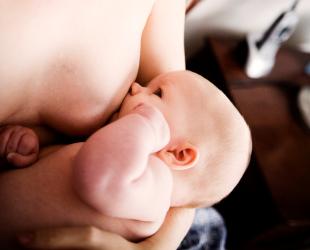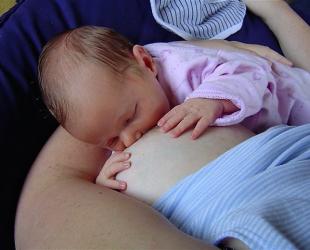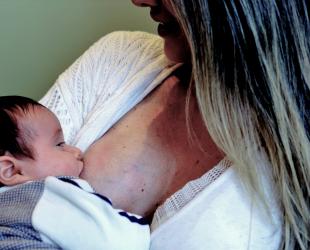Breastfeeding, boobs of all sizes and the changes they go through
Many mums wonder about how their boob size or shape might impact on feeding their baby, especially when preparing for their first child. Jess talks to Naomi about breastfeeding with big boobs, little boobs and everything in between. Naomi also answers the question, ‘What do normal boobs look like?'.

Podcast episode
Companion blog post
Whether your boobs resemble fried eggs, tennis balls, pawpaw or watermelons, there's a breastfeeding technique for you! Nipples can be even more varied in size and shape — I've seen thick and thin ones, pointy shaped, inverted, retracted, flat, pink or brown, areolas as big as saucers and ones like little bottle tops, ones that point down, out, up, sideways, or even one of each. Whatever the size or shape, your baby will learn to work with what is on offer! They are your boobs, and they are just right for your baby. When first learning to drive these bosoms of yours, there may be a bit of fiddling around to get everything working the way it should. Here are my best tips to master your booby machinery ...
Podcast information
Breastfeeding, boobs of all sizes and the changes they go through
Many mums wonder about how their boob size or shape might impact on feeding their baby, especially when preparing for their first child. Jess talks to Naomi about breastfeeding with big boobs, little boobs and everything in between. Naomi also answers the question, ‘What do normal boobs look like?'.
Links to more on topics discussed in this episode:
- Large breasts? Small breasts? Does it matter? information
- How breasts make milk information
- Breastfeeding with large breasts information
- Lopsided breasts information
- Reverse pressure softening information
- Breastfeeding basics video, about how to make feeding comfortable for you and baby
- Positioning information, about how to hold your baby to breastfeed
- Attachment information, about how a baby attaches well to the breast
- Baby Care Rooms program, and information on breastfeeding in public
- Insufficient glandular tissue (breast hypoplasia) information
- Breastfeeding after breast surgery information
- Feeding from one breast information
- Breastfeeding stories ... super leftie podcast episode, talking about one-sided breastfeeding
- Breastfeeding, chest feeding and human milk feeding: Supporting LGBTQIA+ families book, available for purchase as an instant download
- Donor milk information, and ABA's position statement on donor milk
- Using a supply line information
- Breastfeeding: Using a Supply Line booklet, available for purchase as an instant download or order in print format
Credits:
This episode is presented by Jessica Leonard and Naomi Hull.
Audio editing by Jessica Leonard. Show notes by Belinda Chambers. Transcription by
Jessica Pressland-Black. Produced by Belinda Chambers, Jessica Leonard and Eleanor Kippen.
[Music in background]
NAOMI: No matter what size your boobs are, there is no correlation between size and being able to breastfeed, and I've known many women that have A cups that have breastfed their babies for two or three or four years. Yeah.
JESSICA: Welcome to ‘Breastfeeding… with ABA’, a podcast brought to you by volunteers from the Australian Breastfeeding Association. ‘Breastfeeding… with ABA’ is a podcast about breastfeeding, made by parents for parents. In this episode we're chatting about big boobs, small boobs and everything in between.
This podcast records in different parts of Australia. We acknowledge the traditional custodians of the lands we're recording on, and the lands you're listening on. We pay our respects to elders past, present and emerging and to any indigenous people listening. We also acknowledge the long history of oral storytelling on this country and of women supporting each other to learn to feed their babies.
My name is Jess and I'm a breastfeeding counsellor with the Australian Breastfeeding Association. My pronouns are she/her. Today I'm speaking to you from the lands of the Boonwurrung and Wurundjeri people of the Kulin nation.
NAOMI: And my name is Naomi, I'm a breastfeeding counsellor with the Australian Breastfeeding Association. Also, I'm the senior manager for Breastfeeding Information and Research at the Australian Breastfeeding Association, and my pronouns are she and her. I live on the lands of the Jagera and the Turrbal people.
JESSICA: So today we are talking about big boobs, little boobs and everything in between. So, I know a lot of people, especially when they’re going into having their first baby, they might be wondering about, if they've got really big boobs or really small boobs, how that might impact on feeding their baby. So, I just want to start with a question that Naomi perhaps you can answer - what do normal boobs look like?
[Music begins to fade out]
NAOMI: Well, that is a really good question. I don't think there's any such thing as normal boobs. I recently saw a portrait competition that involved pictures of breasts and I can tell you they were all very, very different.
JESSICA: Yeah, absolutely yeah. There's … there's no specific breast that's completely normal, and I think that's probably something that we have been sold as a culture, that there is a normal breast, that they're these like, you know, medium sized perky things, but it's really not the case. You've usually got … one’s at least a little bit bigger than the other, they all point in different directions. They’re different levels of perkiness, sagginess, size, and they're all good boobs. All boobs.
NAOMI: [overlapping] Different nipple shapes too, not just breast.
JESSICA: Absolutely yeah. Yeah, and they’re all, you know, different colours and they get a lot darker during pregnancy as well, so that's quite normal too.
So, why are some boobs bigger than others?
NAOMI: Mmm, so it really just comes down to your individual anatomy. Some people will have larger breasts and that can just be due to the amount of connective tissue, the amount of fatty tissue or the glandular tissue, and that's the one that's specifically related to breast milk storage. But breast size really has no relation to your ability to make enough milk for your baby.
JESSICA: When and why do boobs change in size and shape?
NAOMI: The main changes start occurring in puberty with the onset of menstruation and moving towards your body being ready to have a baby and then the other time that the main changes occur is during pregnancy. So just in that second and third trimester, most women will see some changes occurring in their breast. Usually changes in size and, as Jess already mentioned, changes in colour, particularly the areola and the nipple area.
JESSICA: Yeah, it almost turns into like a target for babies to aim for, doesn't it?
NAOMI: [laughs] I'm pretty sure that's what it's for, yeah!
JESSICA: Yeah, absolutely, and that's actually called … the scientific name for that process is called lactogenesis, so that directly translates into… so lacto means milk, and genesis means beginning, so it's beginning of milk.
So, what about big boobs? What are some helpful things for people who have large breasts when they might be looking at feeding a baby?
NAOMI: Well, during pregnancy, I think for anyone, but particularly if you do have larger breasts, it's good to get a good supportive bra during pregnancy, but also bear in mind that that bra may not necessarily fit you after you've had your baby, 'cause there are some more changes.
And then it is really just about being familiar with your body and used to handling your breasts. Because once you have your baby, breastfeeding will involve a lot of handling your breasts, so that is something to just bear in mind. And then, when you are learning to breastfeed your baby, just knowing that it can take some time to become accustomed to positioning and what works best for you and what works best for your baby. Because it's not the same for everyone. And having larger breasts can just make some of those standard positioning and attachment steps a little bit trickier. Or they might not necessarily work for you, depending on the shape and how your breasts fall.
JESSICA: Yeah, that's right. A lot of it, I seem to find, depends on sort of what direction your breasts are going in as well. So, for some people standing in front of a mirror and actually having a look at their breasts during pregnancy, and just to see that, because that might actually just, you know, have a little trigger in your brain when you go, oh, this one goes a little bit off to this side, so I can try, you know, bringing my baby on from this side to go onto the breast.
NAOMI: That's right.
JESSICA: I know that some people like to use a pillow to help get their baby in the right position when they have really large breasts, especially when the weather is really, really hot.
NAOMI: Yeah.
JESSICA: Because they can get so hot and sweaty having big boobs, and babies can get really hot and sweaty. That you're having that little bit of separation can be really helpful as well.
NAOMI: Particularly if you notice that your nipples actually point down. I have met quite a few women who find that quite challenging because in those early days, when you're learning how to breastfeed, you really want to be able to see what's going on, and if you can't see your nipples, that can be a bit of a mind block for you. But something to know is that your baby is born knowing what to do and your job really is to support your baby and if your baby has the right support and feels safe and secure in how you’re positioned and how you're holding them, then they'll usually … they'll be able to find your nipples and they'll be able to latch on even if you can't see it.
But in that instance, you … that's when a mirror could come in handy. Or even some people just use the reverse camera on their phone so that they can see what's happening, if.. if they feel they need to be able to see what's going on there.
JESSICA: And what about shaping the breast?
NAOMI: Yeah, sometimes, particularly when babies are very new and small, shaping the breasts can just help provide them that sense of grabbing onto something.
JESSICA: Yeah.
NAOMI: Because sometimes when you have bigger breasts, your breast tissue in that area around the nipple and the areola can be a lot rounder and not as easy for your baby to latch onto, so that's where that shaping will help.
JESSICA: In particular, when milk comes in as well, I know that a lot of women, even with smaller breasts, have that problem.
NAOMI: That’s right.
JESSICA: Where it's so full that the skin is so stretched that the nipple … there's not a lot to latch onto, so using something called reverse pressure softening can be really helpful then as well, which is when you sort of just make like, almost like a little claw shape with your hand and just turn your fingertips underneath and just put a little bit of pressure around your nipple and areola, and then gently just push that back a little bit and that will help to soften your breasts and help the nipple to be a little bit more accessible to your baby.
And what about if someone with large breasts is being told that … say they are feeding their baby and they're in a position that feels really, really comfortable and the baby is getting lots of milk, there's lots of good signs that baby is getting enough milk, but someone says that looks wrong. What would you say to that?
NAOMI: Ah! There is no such thing as a right position or a wrong position. It really just goes by what works well for you and your baby. So if, like Jess just said, if … if your baby is latched onto your breast and you can hear those big sucks and swallows, and the baby’s relaxed and you're not feeling any pain or discomfort, then everything is fine. [laughs] And some people will want to comment on how the position looks because they'll have an idea in their mind of what's right and what's wrong. But if it feels good and it's working, then leave it alone [laughs].
JESSICA: Then it's a winner. That's right.
NAOMI: That's right, yeah.
JESSICA: Ok, so I want to talk about … bit more on big breasts and breastfeeding in public. What do you think people need to know about that?
NAOMI: It can be a little scary in the early days because when you're still trying to get used to breastfeeding and positioning and you know where to put your hands and arms and… and… and what position you're gonna hold the baby. But for anyone, no matter what size their breasts, that can be a little daunting, if it's not something you've experienced before. That's where going to an ABA group meeting …
JESSICA: Yes.
NAOMI: … is always a great first trip out because the other people there will be supportive and friendly and probably won't even look sideways at you when you're breastfeeding. So that's a great first trip out.
You can also consider finding somewhere that it's a little quieter or private for you if you are feeling a little bit worried. Of course, it's ok to breastfeed in public, and it's you and your baby’s right to breastfeed wherever you are. But there are quiet and private spaces in many places and that might just be a good strategy for you until you feel more comfortable.
There are also great ways that you can layer your clothing, so that when you need to feed your baby, you don't need to expose as much of your body, because sometimes that can feel a little bit uncomfortable for some people, and in winter it can just be downright cold [laughs], when you have your tummy or the side of your body exposed. So, layering of clothes can be helpful. So, wearing a singlet that's a bit stretchy underneath whatever else you're wearing because you can leave your singlet on then and just pull your breast out of the side of the of the singlet.
JESSICA: Yeah, I always felt very comfortable with breastfeeding in public, but only if I had a shirt that would go down because I felt really uncomfortable exposing my stomach. That was just what I was comfortable with and I know other people have felt the exact opposite way and those … both of those things are fine.
NAOMI: That's right.
JESSICA: Just go with whatever you feel comfortable with and, you know, there's no law about being discreet in a public place. You don't have to.
NAOMI: That’s right.
JESSICA: It's not always possible, especially when babies get a little bit older and they start to get distracted if someone walks by and they want to have a look and see what's going on in the world, you're still protected by that legislation that says that you can breastfeed in public if you and your baby are allowed to be there.
NAOMI: And when I had my babies, they’re a bit old now, they're 21 and 19, but there weren't all these incredible dresses that are available now where you can just lift up enough to get your breast out. I didn't have that option. I had to pull up my shirt and have a cold tummy [laughs].
JESSICA: I want to switch a little bit and talk a little bit about small boobs. So, just to start with, I know that sometimes people have asked me this in the past. If you've got really small boobs, can you still breastfeed?
NAOMI: Absolutely! No matter what size your boobs are, there is no correlation between size and being able to breastfeed, and I've known many women that have A cups that have breastfed their babies for two or three or four years. Yeah.
JESSICA: What about … I'm gonna ask a few questions about some sort of interventions that have happened. So, because we're talking about small boobs, what about breast implants?
NAOMI: Things are definitely improving in the breast implant procedure world. Quite a few years ago most implants were done with a scar that would be left around the nipple area. And of course, that's cutting off that nerve supply that tells your brain and your body to make breast milk. So that was a problem. It didn't always mean that you couldn't make enough milk, but it could pose a problem and hopefully that kind of surgery isn't still occurring. I believe most breast surgery now the scar is well and truly under the breast area, so not as problematic.
The only concern with implants is that sometimes they can leak and there are some concerns about whether that … the silicone from inside the implant, whether that moves into the breast milk and poses a problem for the baby and that, I guess, will be an individual decision for everyone and seek some information out about that.
Also, sometimes that implant, because all the breast tissue is still there, making breast milk isn't generally a problem. But sometimes that implant may put some pressure on some of the milk ducts, and therefore if you find that you're getting mastitis, one of the reasons could be because of that implant. But it's not something that we really hear about commonly.
JESSICA: And what about underlying causes for reasons why people might have gotten breast implants in the first place?
NAOMI: Yeah.
JESSICA: So, there's one in particular that does come up. It's a fairly rare condition, so it's called insufficient glandular tissue. Can you talk a little bit about that?
NAOMI: Yeah, so, insufficient glandular tissue, often you might see it called IGT, is where the milk making tissue of the breasts, the glandular tissue, hasn't developed fully for some reason, and that is usually something that will happen during, or not happen … during puberty. There isn't a huge amount of research on how insufficient glandular tissue is diagnosed, so I can't say definitively what that is. There is work currently being done in Australia on this, which is quite exciting, so we will know more soon, but often how we think of it is if there is a big gap between the breasts, and it's usually around 4 to 5 centimetres between the breasts, that can be an indication that you might have insufficient glandular tissue. And then sometimes the shapes, so, you might have tubular looking breasts. And once again, like everything, nothing is definite. So, if you're listening to this and you're thinking, oh, I've got a big gap between my breasts, please know that it doesn't necessarily mean that you won't be able to make enough milk for your baby.
JESSICA: Yeah, that's right, yeah.
NAOMI: It's just worth seeing a lactation consultant if you can. Chatting to an ABA breastfeeding counsellor and just gathering as much information as you can.
JESSICA: Yeah, absolutely. So, what about other types of surgery? So, we've talked a bit about surgery where we've got breast implants going in. What about surgery where there might be breast tissue being removed or sort of cut into? So, things like breast reductions, gender affirmation surgeries, or even sort of treatments like lumpectomies. How can they affect feeding a baby?
NAOMI: Yeah, well we’ll start with the smallest, the lumpectomies. So, lumpectomies or even biopsies. Of course, they’re where there's been some surgical intrusion into the breast, so there's always a chance that there could be some nerve damage or even some severing of a milk duct, for example. So, those kind of procedures often don't cause any problems, but once again, if you find yourself getting recurrent mastitis, it could be for that reason.
Whereas, breast reduction is when there's been a larger removal of breast tissue, and so that could just mean that you've had a sizable amount of your milk-making tissue removed. The good thing is, is that the…the milk-making tissue, the glandular tissue, that you still have left behind, if stimulated enough will make enough milk for your baby. But it's just something to be aware of and something that you can just pre-arm yourself with information and educate yourself and have those strategies in place and… and just know what to look out for as well.
JESSICA: Yeah, absolutely. And you know, there's a lot of good books out there, there's information on our website, if you have had one of those types of surgeries. And you can speak to a breastfeeding counsellor about getting support and how you can continue to feed your baby even if you aren't able to make enough milk. If you have had a significant amount of breast tissue removed, it is still possible to feed your baby and you know there are a lot of options for that, yeah.
NAOMI: Yeah, that's right. And then mastectomies, whether that's a single mastectomy, or whether you've had both breasts removed, of course, that's… they’re different scenarios again. So, removal of one breast, it is still possible to breast feed with one breast. In fact, we have another podcast called Super Lefty.
JESSICA: Yes [laughs].
NAOMI: And that one is all about the experience of breastfeeding on one side. So, it is absolutely possible to breastfeed on one side.
If you've had both… both breasts removed for whatever reason, of course that's a completely different scenario. Unfortunately, if you don't have any breast or milk making tissue, then it won't be possible to feed a baby with milk made by your body, but there are other ways that you can provide human milk to your baby through donor milk. And there's a thing called a supply line, which there's information about that on our website, and we also have a couple of booklets. We have the ‘Breastfeeding, chest-feeding and human milk feeding’ booklet that we co-designed with Rainbow Families New South Wales. And we also have our ‘Using a supply line’ feeding booklet that talks about how to feed your baby milk at the body or at the breast with milk that's been donated.
JESSICA: So, I'll explain a little bit about what a supply line is, and what it does. So, if you can picture a bottle of milk that's on a necklace hanging around your neck, and then you've got a tiny little, very fine tube of silicone that comes out of the bottle, so there's no teat on the bottle. There's a tiny, fine, tube, and that comes all the way down. And most often that is taped next to the nipple and then the nipple goes into the baby's mouth and the fine tube of silicone also goes into the baby's mouth. So, if you already have a supply of breast milk, that can be used to give extra milk to your baby while they're feeding at the breast. So, a lot of people do use that if they are working with a lactation consultant to build their supply, but it can also be useful in situations where you might have had a significant amount of breast tissue removed, but you still have a nipple. So, if you're not able to create a full supply of breast milk, that can be done that way.
[Music fades in]
Some people do also use a clean finger with a supply line to feed their baby that way as well and hold them in a breastfeeding position. So, for example, if a woman had had a double mastectomy and she didn't have any nipples to feed her baby on, that might be a way that she can feed donated human milk from her body by using her finger to feed her baby so it … it is a really interesting way. There are a lot of things that I think a lot of people aren't necessarily aware of that are around to support people to feed their babies.
NAOMI: And for more information on donor milk, we have a donor human milk position statement as well on our website. We'll put a link in the show notes.
JESSICA: Fantastic. Is there anything else that you would like to add about big boobs, little boobs, anything in between?
NAOMI: [laughs] Just love what you've got, I think.
JESSICA: Fantastic, I think that's such good advice.
Well thank heaps Naomi for chatting with me today. You can check the show notes for a link to this episode’s blog and to other information as well.
If you're in a position to support the work ABA does financially, you can become a member by visiting breastfeeding.asn.au and that'll link you in with your local group as well.
If you need some online support, you can join our ‘Breastfeeding with ABA’ Facebook group. So, there's three joining questions to get into that group; just make sure you answer those first.
If you want to speak to a breastfeeding counsellor, you can call the National Breastfeeding Helpline on 1800 686 268. So that's open 24 hours a day, every day of the year. Our live chat service is also another option, so you can check the website to see when that's open.
Thanks heaps for listening. We'd love it if you can rate, review and subscribe to the ‘Breastfeeding… with ABA’ podcast, wherever you're listening.
END
- Access our free info kit.
- Download our mum2mum app via the App store or Google Play.
- Call the National Breastfeeding Helpline on 1800 686 268, available 24 hours a day, 7 days a week.
- Chat with a volunteer via LiveChat on our website.
- Sign up for an interactive and informative local breastfeeding class or online breastfeeding workshop.
- Get books and resources on general and specialist breastfeeding topics.
- Join ABA as a member to get your free copy of our best-selling book Breastfeeding … naturally + free access to all premium content on the mum2mum app + discounted breastfeeding classes + half-price breast pump hire + unlimited access to ABA events + more!



